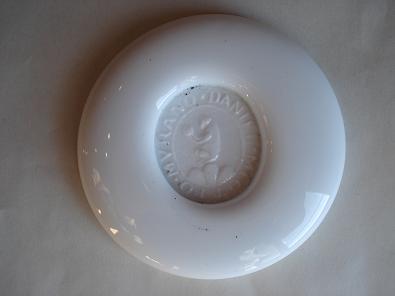Storia del vetro di Murano
I falsi smalti Miotti fatti in Inghilterra nel settecentoThe false Miotti enamels made in England in the 18tcentury

La famiglia Miotti è rimasta famosa nella storia dell'arte vetraria veneziana per gli smalti. Quelli adoperati per decorare metalli, ceramiche e vetri venivano confezionati in pani, che le leggi della Serenissima imponevano fossero marchiati con il “bollo” del produttore. I pani erano rotondi con diametro intorno ai 10 cm. e i marchi più noti erano la sirena, il sole, il Gesù e la scimmia (i due ultimi erano dei Miotti).
Nel 1765 Alvise Miotti scopriva che in Inghilterra si imitavano i suoi smalti falsificandone il marchio. L'ambasciatore veneziano a Londra, incaricato di svolgere indagini, comunicava che venivano fatti a Londra e a Birmingham.
Miotti Family’s renown in the venetian glass manufacturing history is due to the enamels. According to Serenissima Republic’s law, metals, ceramics and glass were decorated by enamel pats which were to be marked by the producers. The pats were round shaped with a diameter of 10 cm. approximately. The most famous marks were the mermaid, the sun, Jesus Christ and the monkey (the last two marks belonging to Miotti Family).
In 1765 Alvise Miotti did find out that his enamels were copied in England by faking his mark. Venetian Ambassador in London investigating the matter informed that enamels were reproduced in London and Birmingham.



Paolo Zecchin Via Cappuccina 13 Mestre Venezia
The false Miotti enamels made in England in the 18tcentury
La famiglia Miotti è rimasta famosa nella storia dell'arte vetraria veneziana per gli smalti. Quelli adoperati per decorare metalli, ceramiche e vetri venivano confezionati in pani, che le leggi della Serenissima imponevano fossero marchiati con il “bollo” del produttore. I pani erano rotondi con diametro intorno ai 10 cm. e i marchi più noti erano la sirena, il sole, il Gesù e la scimmia (i due ultimi erano dei Miotti).
Nel 1765 Alvise Miotti scopriva che in Inghilterra si imitavano i suoi smalti falsificandone il marchio. L'ambasciatore veneziano a Londra, incaricato di svolgere indagini, comunicava che venivano fatti a Londra e a Birmingham.
Miotti Family’s renown in the venetian glass manufacturing history is due to the enamels. According to Serenissima Republic’s law, metals, ceramics and glass were decorated by enamel pats which were to be marked by the producers. The pats were round shaped with a diameter of 10 cm. approximately. The most famous marks were the mermaid, the sun, Jesus Christ and the monkey (the last two marks belonging to Miotti Family).
In 1765 Alvise Miotti did find out that his enamels were copied in England by faking his mark. Venetian Ambassador in London investigating the matter informed that enamels were reproduced in London and Birmingham.



Paolo Zecchin Via Cappuccina 13 Mestre Venezia
La famiglia Miotti è rimasta famosa nella storia dell'arte vetraria veneziana per gli smalti. Quelli adoperati per decorare metalli, ceramiche e vetri venivano confezionati in pani, che le leggi della Serenissima imponevano fossero marchiati con il “bollo” del produttore. I pani erano rotondi con diametro intorno ai 10 cm. e i marchi più noti erano la sirena, il sole, il Gesù e la scimmia (i due ultimi erano dei Miotti).
Nel 1765 Alvise Miotti scopriva che in Inghilterra si imitavano i suoi smalti falsificandone il marchio. L'ambasciatore veneziano a Londra, incaricato di svolgere indagini, comunicava che venivano fatti a Londra e a Birmingham.
Miotti Family’s renown in the venetian glass manufacturing history is due to the enamels. According to Serenissima Republic’s law, metals, ceramics and glass were decorated by enamel pats which were to be marked by the producers. The pats were round shaped with a diameter of 10 cm. approximately. The most famous marks were the mermaid, the sun, Jesus Christ and the monkey (the last two marks belonging to Miotti Family).
In 1765 Alvise Miotti did find out that his enamels were copied in England by faking his mark. Venetian Ambassador in London investigating the matter informed that enamels were reproduced in London and Birmingham.
